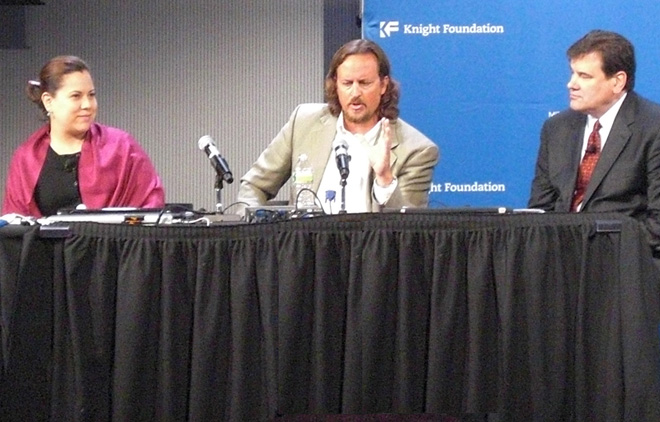
Civic media mobilization: putting down the screens, and putting on a T-shirt
“Like” it? Put it on a t-shirt.
Social media tools may connect us over geographic or social barriers, but are we hitting that “Like” button too much rather than actively participating in our own governance? Chris Faulkner thinks so. As a political consultant and Tea Party member, he wants to see people leave their screens and congregate in person more often.
“If you don’t get together, you won’t move the ball,” Faulkner said.
In a plenary session on civic media mobilization, Faulkner and Yesenia Sanchez, an organizer for P. A. S. O./Illinois Coalition for Immigrant and Refugee Rights, emphasized the importance of face time in their work over electronic social connections. Knight’s National Program Director Damian Thorman, who heads Knight’s Technology for Engagement initiative, moderated the panel at the MIT-Knight Civic Media Conference.
Faulkner believes in the power of the political rally. Although he credits Twitter with a vital role in forming the Tea Party in 2009, he says groups really gelled when they saw signs made by fellow Tea Partiers at demonstrations. That’s when they became fans—who would wear the T-shirts—rather than just supporters who would hit that “Like” button.
For Sanchez (who only joined Twitter after being convinced by fellow Civic Media Conference attendees. Follow her at @yeseniapaso), it’s not the handshake but the knock on the door or the visit to a classroom that makes a difference to her work. Social media tools certainly play a main role in connecting undocumented youth to each other without drawing too much attention, but her work is most effective because she canvases door-to-door and takes her message to the streets.
Sanchez said videos on Youtube of the Undocumented, Unafraid and Unapologetic campaign, remarkably still not noticed by main stream media, energizes the youth in her organization, in the same way televised SNCC acts of civil disobedience encouraged more students to participate during the Civil Rights movement in the US.
Faulkner pointed out that political campaigns are still all about raising money, and he said he’d love to see a measure of the correlation between online campaign contributions during televised debates. Individuals have more political power now that online giving is so easy, he said. For organizing, he stressed that one has to go to where most people are. Although it might seem “old school,” most voters are still more comfortable on Yahoo groups, Meet-Up and Facebook.
As for measuring impact, Faulkner and Sanchez count feet. You can see the effects of your hashtags, your email blasts or your tweets when you see who shows up at your rally. At an Illinois state capitol rally, the 900 people who arrived told Sanchez her message was getting out.
Ethan Zuckerman, director of the Civic Media Center, asked the panelists how we can find people who wouldn’t necessarily connect with us. Sanchez explained the need to educate people about the ripple effects of having undocumented immigrants live among us—that someone close to you in school or at work, may be keeping their identity a secret. Faulkner makes use of common causes to draw people together, such as when the Tea Party focuses people’s outrage on federal spending.
“You have to make people angry sometimes, to move them,” he said.
Annie Shreffler is a freelance journalist covering the MIT-Knight Civic Media Conference for Knight Foundation
Recent Content
-
Journalismarticle ·
-
Journalismarticle ·
-
Journalismarticle ·


